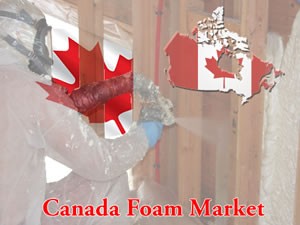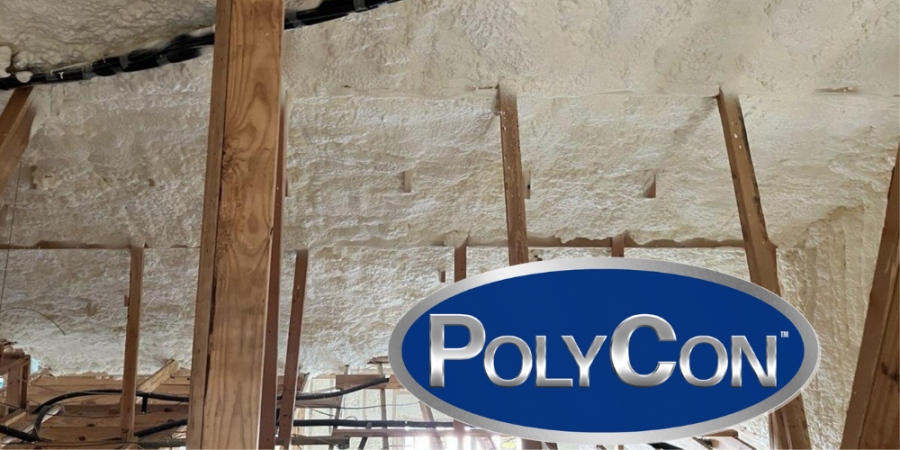The Canadian Spray Foam Market Is Thriving

May 14, 2009 – While the spray foam industry has been rapidly expanding in the United States, the growth of the Canadian market has also been increasing in momentum. Many notable events have accompanied this rise in prominence there.
Lapolla Industries, Inc., based in Houston, TX, recently earned Canadian Product Approval through the Canadian Construction Materials Center (CCMC) and decided to expand sales and distribution operations into the Canadian market, opening a headquarters in Toronto, Ontario. Another Ontario based company, Home Foam is in development of a foam-based batt insulation product. Icynene, also based in Ontario, is innovating the market with the upcoming release of ICYNENE LD-R-50™, a renewable castor oil-based insulation and air barrier material that reduces the need for petroleum-based polyols. On the negative side, RetroFoam Canada was recently named in a $500 million class action lawsuit for distributing injection foam insulation containing the banned substance Urea Formaldehyde.
Despite being in close geographic proximity to the US, the Canadian spray from market has its own unique characteristics and challenges, starting with the strict regulations applied to all spray foam products.
Marc Kast, General Manager of Lapolla’s Canadian operations, points out, “The requirements for foam in Canada are one of the toughest specs in the industry and only the very best systems have a chance of meeting the Canadian standards.” Alison Scott Bull, Vice President of Sales in Canada for Icynene agrees with his assessment. “The code situation in Canada is very different than the US. Vapor barriers are required under code, and reinforced by CCMC. All foamed plastics must also be covered by approved thermal barriers. There is no allowance to use thermal ‘coatings’; it must be a full thermal barrier. The test methodologies used in Canada can also be very different. For example, the test utilized to determine flame and smoke numbers is much more challenging in Canada than the US. Additionally, code bodies are linked through provincial and federal code bodies. Contrary to the US, there are very few regional code modifications that happen in Canada.”
Trade organizations such as Canadian Urethane Foam Contractors Association (CUFCA) also play an important role in the Canadian foam market. CUFCA is a contractor association that is responsible for training, certification and quality control with mandatory and random onsite inspections. Membership in such organizations adds legitimacy to Canadian based spray foam companies but also adds to the requirements they must meet.
While the market in Canada technically consists of roofing, commercial insulation and residential insulation segments as in the US, Kast affirms that the segmentation in their country is dramatically different. He asserts that “insulation accounts for 99% of the Canadian market. Roofing is basically nonexistent as our weather/climate is not ideal for this application; the climatic window is quite small.”
As for the most difficult obstacle of the Canadian spray foam market, Kast cites the “sheer size of the country and the fact that the population is so spread out” as the largest challenge for both contractors and suppliers.
Scott Bull, on the other hand, asserts that the consumer purchasing habits of Canadians are a significant stumbling block because they are “much more conservative in comparison with US consumers. While Canadian consumers are beginning to understand the air-sealing benefits that spray foam provide, many still need more education to overcome the price difference versus more conventional insulation options. For this reason, many either default to fiberglass or they utilize foam in the areas where it can deliver the biggest bang for the buck, such as rim joists and bonus rooms. Recently, other application areas, such as the floor of the attic, are increasingly gaining attention as the consumer becomes more educated about the advantages of spray foam.”
She continues, “The major misconception among consumers (and therefore serves as an obstacle to the acceptance of spray foam) is that homes can be ‘too tight’. Even though our Canadian government coined the phrase “Build Tight, Ventilate Right” back in the 1980s, consumers still require more education to help them see that, combined with proper mechanical ventilation, achieving a superior air-seal with a product like Icynene can help improve indoor air quality and deliver energy savings of up to 50% every month.”
Scott Bull maintains a very optimistic attitude that “the future of the spray foam insulation market in Canada is very bright. As consumers and builders gain more working knowledge of the benefit of air tight construction and proper ventilation, the use of polyurethane foam will explode. It is an exciting time to be involved in the insulation market, as our construction methodology shifts to accept the use of foam as the primary insulation material. Once people understand the overall benefits that polyurethane foam can provide including an effective moisture management strategy, increased indoor air quality, comfort and energy efficiency, they will follow the trend that has already begun in the U.S. with upgrading to foam insulation as the primary insulating and air barrier product used in their homes.”
Kast, however, takes a more cautious tone, suggesting that “the Canadian Market for spray foam insulation is a mature market that has moderate growth potential. We have seen quite an expansion in the amount of contractors over the past 3 years and this expansion has outpaced the growth in the industry. The balance of 2009 and for 2010 many of these new enterprises will fail due to the contraction of the economy and the reduction in the building industry. We expect that 2011 will see the return of moderate growth of 10-15% return to the building industry. The Canadian economy relies heavily on the US economy and until the US economy recovers fully from its current recession our growth will be hampered.”
Although current economic conditions will surely play a role in the growth of this market, it is likely that the Canadian market will continue to grow steadily as initial barriers are overcome. As distribution channels improve and the benefits of spray foam become more widely known, the momentum that is already apparent within the Canadian market should continue to gather speed.
Companies featured in this article:
Demilec LLC
LaPolla Industries, Inc
Icynene, Inc
Disqus website name not provided.









































